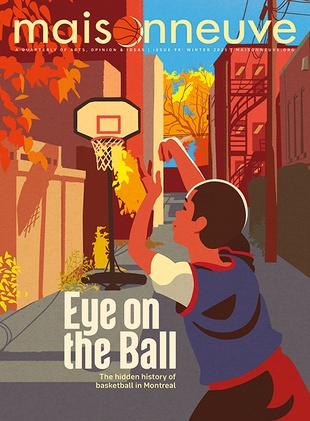They Were There
Breaking News turns the lens on the Associated Press
In 1927, when anarchists Nicola Sacco and Bartolomeo Vanzetti were executed in Massachusetts for the murder of two people during a robbery, only one reporter was allowed into the electrocution chamber—an agent of the Associated Press. Nearly seventy years later, when Orenthal James Simpson went before the courts in another explosive trial that gripped the imagination of the United States, the judge chose Associated Press reporter Linda Deutsch to cover the proceedings, transmitting all she saw and heard to the pool of reporters outside for whom there wasn't enough room in the Los Angeles courtroom.
Such is the authority and influence of the AP—those famous initials that appear prominently in the byline of countless news stories every day—that even the legal system itself has conceded that the organization plays a special role in the news media. Since it was formed by an ad hoc group of New York newspapers in 1846 to reduce costs in covering the Mexican-American War by setting up its own pony express route, the cooperative has been on the front lines of every major US-related news event all over the world. Election after election, they were first with the results; when Saigon fell in 1975, they were last out of Vietnam.
Breaking News: How the Associated Press Has Covered War, Peace and Everything Else (Princeton Architectural Press) is the first book in sixty-six years to turn its lens on the venerable news agency itself—to watch the watchers, as it were, and the picture that emerges is one of an organization whose influence over the course of events over the past 161 years cannot be underestimated.
The book may sometimes skew events to make it seem as if the AP has been the lone voice of American news all these years—each chapter was written by a journalist with some connection to the AP—but its mandate is not to chronicle the last century-and-a-half, but to show how AP covered those events. Nonetheless, the deeper one sinks into this book, the more apparent it becomes that the AP has been more than a chronicler—it has been a participant in history itself.
Nowhere is this more apparent than in the chapters dealing with the tumultuous 1960s, when America and much of the Western world underwent a social tremor that reverberates to this day. In his foreword to Breaking News, the veteran New York Times reporter David Halberstam—whose life was cut short by a terrible car accident in California just this past April—asserts that the AP played a crucial role in turning public opinion against the war in Vietnam. Halberstam attributes this to the foresight of AP's editors, who had reporters on the ground in Saigon long before the US military took up a combat role there in 1965.
"Because [the AP's reporters] had gotten there very early," Halberstam wrote, "they all had an exceptional feel for it, and they tended to see it more through the prism of Vietnamese history than of American history ... Thus, even as the war was Americanized, these reporters possessed a certain skepticism that many of their journalistic colleagues lacked."
(Among those remarkable journalists was a relatively young Peter Arnett, who as a CNN correspondent in 1991 gained unprecedented fame as the "Scud stud" whose live, on-air reports on the bombing of Baghdad from underneath his bed in the Al-Rashid Hotel have become the stuff of legend.)
Meanwhile, back in America, a different war was being fought. The civil rights movement hit its peak in the 1950s and 1960s, as America’s black population marched in the streets for desegregation and an equal shot at the American dream. In 1962, James Meredith, the first black person admitted to the University of Mississippi, set off on an anti-segregation “march against fear” across the state of Mississippi. Meredith was eight miles into his walk when a sniper fired some ninety birdshot pellets into his head, back, neck and legs. AP photographer Jack Thornell captured the attempted assassination with his camera. It was only later, in the darkroom, that Thornell saw the sniper in the frame of his shots—Thornell had been directly in the line of fire when he snapped the photos.
For many Southern newspapers, whose editors and readers were often unsympathetic to the civil rights movement, the AP provided a way by which the papers could report the protests, sit-ins, marches and violent clashes without drawing their readers’ ire. “Printing a wire service story inoculated them from readers’ criticism,” Mike Feinsilber writes in the chapter on civil rights in Breaking News.
Arguably, the civil rights movement’s zenith ended at a motel in Memphis, Tennessee, on April 4, 1968, with the assassination of the Rev. Martin Luther King, Jr. Kathryn Johnson was AP’s woman in King’s hometown of Atlanta at the time, and her friendship with the King family was so strong that when Jackie Kennedy came to the King home to offer her condolences, she found Johnson, dressed in an apron, cooking eggs and bacon for the King children.
It’s at times like these that one has to stop and consider just how close to a story a reporter or a news organization should get. In perhaps the darkest chapter of the AP’s history, the organization got so close to the story—coverage of the 1876 presidential election between Democrat Samuel J. Tilden and Republican Rutherford B. Hayes—that it more than likely influenced the outcome of the event it was covering.
In 1876, the general manager of the AP’s Chicago-based western bureau was William Henry Smith, one of Ohio governor Rutherford Hayes’ closest friends. Throughout the 1876 election, the western bureau “made it virtually impossible for Tilden’s campaign material to reach the public through its service,” Tom Jory writes in his chapter on elections. And Smith’s relationship with telegraph operator Western Union “gave Republicans ‘access to Democratic dispatches to and from the South during the crucial stages of the [vote] count. He could thus anticipate the movements of the Democrats’…”
It’s hard to imagine, in our day and age, a news organization becoming so directly involved—and in such a partisan manner—with a political movement. Yet we live in a political environment where accusations of bias by the press are everywhere. Left-wingers decry the conservative leanings of Fox News (“Faux News,” they call it), while the conservatives on Fox attack the New York Times for its “liberal agenda.”
Perhaps it is the fear of being slapped with a bias label that accounts for why so many observers of the media see today’s news organizations as being anemic and ineffective when compared to the active roles that they took during the upheavals of the Vietnam and civil-rights era. In Halberstam’s foreword to Breaking News, there is a definitive sense of something lost since those heady days.
“We live in a time now when the [journalistic] values of that era seem ever more distant,” he writes. “Television dominates the play, and more and more coverage is about celebrities and scandals; when it comes to big stories, more often than not the networks do it in a preening way … They come to a story a little too late and they leave a little too early.”
Indeed, Fox News commentator Bill O’Reilly announced not long ago that he would no longer be covering the war in Iraq on his prime-time show, because he can’t get decent information about what’s going on there. Though in O’Reilly’s case this is likely just an excuse to avoid a topic that is causing growing embarrassment for his Republican allies, his assertion does point out the inadequacies of Iraq war reportage, especially when compared to earlier wars.
“Between 2002 and 2006, the number of [American] foreign-based newspaper correspondents shrank from 188 to 141,” Pamela Constable wrote in the Washington Post earlier this year. “The Baltimore Sun, which had correspondents from Mexico to Beijing when I went to work there in 1978, now has none.”
Constable goes on to quote Walter Cronkite, the former host of the CBS Evening News, known for the longest time as “the most trusted man in America,” who in 1968, after touring Vietnam, declared the war a last cause in front of a live national audience. At a speech at Columbia University this February, Cronkite warned that the pressure on media companies to increase profits is damaging their ability to gather and report news.
“The need for high-quality reporting is greater than ever,” he told the crowd. “It’s not just the journalist’s job at risk here. It’s American democracy.”
In that context, we can only hope that Breaking News will prove to be just the first volume in a long history of meaningful North American journalism, and not a chronicle of the demise of the newsroom.
Daniel Tencer is a regular contributor to Maisonneuve's MediaScout.





